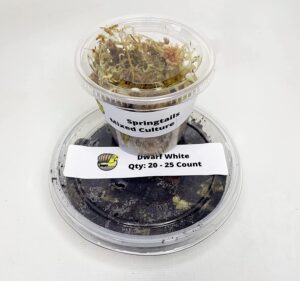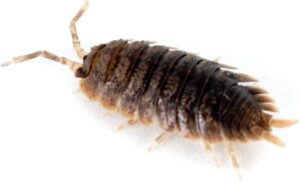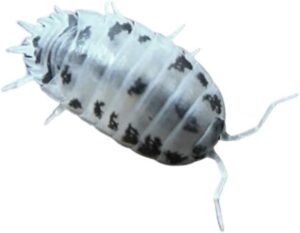Outdoors
Best Isopods for Leopard Geckos: A Comprehensive Guide
Leopard geckos are a popular pet lizard species known for their hardiness and ease of care. As a responsible pet owner, it’s important to provide your leopard gecko with a balanced and nutritious diet. One question that often arises is whether or not leopard geckos can eat isopods. In this article, we’ll explore this question in more detail and provide some important information to help you make an informed decision.
Top 3 Best isopods For Leopard Geckos
| Image | Product | Rating | Buy On Amazon |
|---|---|---|---|
 | Bugzy Bugs Dwarf White & Springtail Bundle Live Isopods Trichorhina Tomentosa Bioactive Feeders | 4.2 | AMAZON |
 | Josh's Frogs Porcellio dilatatus 'Giant Canyon' Isopods (10 Count) | 5 | AMAZON |
 | EZ Botanicals Live Dairy Cow (Porcellio Laevis) Isopods | 4.1 | AMAZON |
-
- Dwarf White Isopods (Trichorhina tomentosa)
Dwarf White Isopods are a popular choice for leopard gecko terrariums due to their small size and ability to consume a wide range of organic matter, including decaying wood and leaf litter. They are easy to care for and reproduce at a moderate rate, making them a great option for those who want to maintain a clean and healthy terrarium without overpopulation issues.
Pros:
- Small size makes them easy to hide in the terrarium
- Can consume a wide range of organic matter
- Easy to care for
- Moderate reproductive rate
Cons:
- May not be suitable for larger terrariums
- May not be readily available in all areas
- Can be difficult to distinguish from other isopod species
- Giant Canyon Isopods (Porcellio dilatatus)
Giant Canyon Isopods are a larger species of isopod that are native to the southwestern United States. They are known for their unique appearance and ability to consume a wide range of organic matter. They reproduce at a moderate rate and can help to maintain a clean and healthy terrarium environment.
Pros:
- Unique appearance
- Can consume a wide range of organic matter
- Moderate reproductive rate
Cons:
- Larger size may make them difficult to hide in the terrarium
- May not be suitable for smaller terrariums
- Can be difficult to obtain
- Dairy Cow Isopods (Porcellio laevis “Dairy Cow”)
Dairy Cow Isopods are a popular choice for leopard gecko terrariums due to their distinctive black and white coloration. They are able to consume a wide range of organic matter and reproduce at a moderate rate, making them a great option for maintaining a clean and healthy terrarium environment.
Pros:
- Distinctive black and white coloration
- Can consume a wide range of organic matter
- Moderate reproductive rate
Cons:
- May be difficult to distinguish from other isopod species
- May not be readily available in all areas
- May not be suitable for larger terrariums
Can Leopard Geckos Eat Isopods?
The short answer is yes, leopard geckos can eat isopods. In fact, isopods can provide a number of benefits for leopard geckos, including:
- Nutritional Value: Isopods are a good source of protein, fiber, and other important nutrients that can help to support your leopard gecko’s overall health and well-being.
- Natural Diet: In the wild, leopard geckos will often consume isopods as part of their natural diet. By providing isopods as a food source in captivity, you can help to replicate a more naturalistic environment for your pet.
- Terrarium Maintenance: Isopods can also play an important role in maintaining a clean and healthy terrarium environment. They help to break down organic matter and waste, which can reduce the risk of bacterial growth and other potential health hazards for your pet.
Choosing the Right Isopods for Your Leopard Gecko
If you’re interested in providing isopods as a food source for your leopard gecko, it’s important to choose the right species. Not all isopods are created equal, and some may not be suitable for consumption by your pet. Here are a few factors to consider when selecting isopods for your leopard gecko:
- Size: Isopods come in a variety of sizes, from small “dwarf” species to larger “giant” species. It’s important to choose a size that is appropriate for your leopard gecko’s size and feeding habits.
- Diet: Some isopod species are herbivores, while others are omnivores or carnivores. It’s important to choose a species that has a diet that is appropriate for your leopard gecko’s nutritional needs.
- Availability: Not all isopod species may be readily available in your area. It’s important to research which species are available and legal to purchase in your region.
Feeding Isopods to Your Leopard Gecko
When feeding isopods to your leopard gecko, there are a few important considerations to keep in mind:
- Quantity: Isopods should be fed in moderation as part of a balanced diet. Too many isopods can lead to overfeeding and potential health issues for your pet.
- Preparation: Isopods should be fed live or freshly killed. Do not feed your leopard gecko with isopods that have been dead for an extended period of time or that have been kept in unsanitary conditions.
- Size: As mentioned earlier, it’s important to choose isopods that are an appropriate size for your leopard gecko’s feeding habits. Large isopods may need to be cut into smaller pieces before feeding.
Leopard geckos are known for their unique appearance and easy-to-care-for nature, which makes them an ideal pet for beginner and experienced reptile owners alike. However, like all pets, leopard geckos require proper care and maintenance to thrive in captivity. One essential aspect of leopard gecko care is maintaining a clean and healthy terrarium environment. This is where isopods come in.
Isopods are small, crustacean-like creatures that play a crucial role in maintaining a clean and healthy terrarium environment. These tiny critters are natural cleaners that help break down and decompose organic waste, such as leftover food and fecal matter. Isopods also help to aerate the substrate, which improves drainage and reduces the risk of bacterial and fungal growth.
Here, we’ll take a closer look at the best isopods for leopard geckos, what to consider when selecting isopods, and how to care for them properly.
What are isopods?
Isopods are a group of crustaceans that are commonly referred to as pill bugs, woodlice, or roly-polies. They are found in a wide range of habitats, including soil, leaf litter, and rotting logs. Isopods have a hard, exoskeleton that protects their bodies and allows them to roll up into a ball when threatened.
In a leopard gecko terrarium, isopods can help to maintain a clean and healthy environment by breaking down organic waste and aerating the substrate. Isopods are also beneficial because they do not pose a threat to leopard geckos and can even serve as a source of food for juvenile geckos.
Some common isopod species that are used in leopard gecko terrariums include:
- Armadillidium maculatum: Also known as zebra isopods, these isopods have a distinctive black and white striped pattern. They are relatively small and are great for smaller terrariums.
- Porcellio laevis: These isopods are larger than Armadillidium maculatum and have a smooth, shiny appearance. They are very active and are great for larger terrariums.
- Porcellionides pruinosus: These isopods are also known as powder orange isopods because of their bright orange color. They are a bit larger than Armadillidium maculatum and are great for larger terrariums.
Factors to Consider When Choosing Isopods for Leopard Geckos
When selecting isopods for your leopard gecko’s terrarium, there are a few factors to consider to ensure that you choose the right species for your pet’s needs. Here are some of the most important factors to consider:
- Size: It’s important to choose isopods that are an appropriate size for your leopard gecko’s terrarium. If you have a smaller terrarium, you’ll want to choose smaller isopods like Armadillidium maculatum. If you have a larger terrarium, you can opt for larger isopods like Porcellio laevis or Porcellionides pruinosus.
- Activity level: Some isopod species are more active than others. If you have a larger terrarium, you may want to choose more active species like Porcellio laevis or Porcellionides pruinosus to help keep the substrate aerated and healthy.
- Diet: Isopods have different dietary needs depending on their species. Some isopods are detritivores, meaning that they feed
on decaying organic matter, while others are omnivores and may consume plant matter as well. It’s important to choose isopods that have a diet that is appropriate for your leopard gecko’s terrarium environment.
- Reproduction rate: Isopods can reproduce quickly, which can lead to an overpopulation problem if not managed properly. Some species reproduce more slowly than others, so it’s important to choose isopods that will reproduce at a rate that is appropriate for your terrarium’s needs.
- Availability: Not all isopod species are readily available in all areas, so it’s important to choose a species that you can easily obtain in your area.
How to Care for Isopods in a Leopard Gecko Terrarium
Once you’ve selected the right isopods for your leopard gecko’s terrarium, it’s important to ensure that you provide them with the proper care and maintenance to keep them healthy and thriving. Here are some tips for caring for isopods in a leopard gecko terrarium:
- Provide a suitable substrate: Isopods require a substrate that is moist and provides enough organic material for them to feed on. A substrate made of coconut coir or sphagnum moss can provide a suitable environment for isopods to thrive.
- Ensure proper temperature and humidity: Isopods thrive in warm, humid environments. It’s important to ensure that the terrarium is kept at a temperature and humidity level that is suitable for the isopod species you’ve chosen.
- Provide hiding spots: Isopods like to hide in dark, damp places. Providing hiding spots, such as pieces of bark or cork bark, can help to create a more naturalistic environment for your isopods.
- Offer a varied diet: Depending on the isopod species, they may require a varied diet that includes decaying organic matter, fruits, and vegetables. It’s important to research the dietary needs of the isopods you’ve chosen and provide a varied diet to ensure their health and well-being.
- Monitor population levels: Isopods can reproduce quickly, so it’s important to monitor their population levels to prevent overpopulation. If necessary, you may need to remove some isopods from the terrarium to maintain a healthy balance.
Conclusion:
Isopods can play an important role in maintaining a clean and healthy terrarium environment for your leopard gecko. By choosing the right species and providing them with proper care and maintenance, you can ensure that your isopods thrive and help keep your pet’s terrarium clean and healthy.
leopard geckos can eat isopods as part of a balanced diet. Isopods provide a number of benefits for leopard geckos, including nutritional value and naturalistic feeding habits. When selecting isopods for your pet, it’s important to consider factors such as size, diet, and availability. As with any food source, isopods should be fed in moderation and prepared properly to ensure the health and well-being of your leopard gecko.

